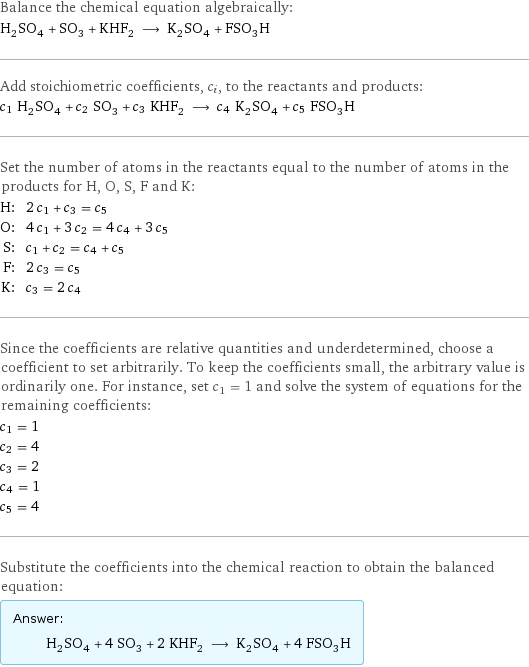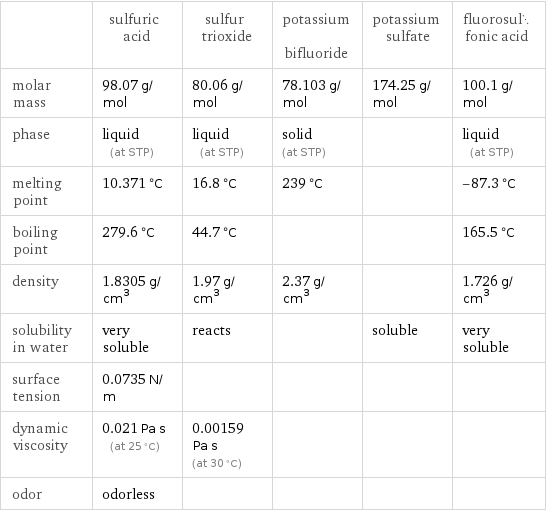Input interpretation

H_2SO_4 sulfuric acid + SO_3 sulfur trioxide + KHF_2 potassium bifluoride ⟶ K_2SO_4 potassium sulfate + FSO_3H fluorosulfonic acid
Balanced equation

Balance the chemical equation algebraically: H_2SO_4 + SO_3 + KHF_2 ⟶ K_2SO_4 + FSO_3H Add stoichiometric coefficients, c_i, to the reactants and products: c_1 H_2SO_4 + c_2 SO_3 + c_3 KHF_2 ⟶ c_4 K_2SO_4 + c_5 FSO_3H Set the number of atoms in the reactants equal to the number of atoms in the products for H, O, S, F and K: H: | 2 c_1 + c_3 = c_5 O: | 4 c_1 + 3 c_2 = 4 c_4 + 3 c_5 S: | c_1 + c_2 = c_4 + c_5 F: | 2 c_3 = c_5 K: | c_3 = 2 c_4 Since the coefficients are relative quantities and underdetermined, choose a coefficient to set arbitrarily. To keep the coefficients small, the arbitrary value is ordinarily one. For instance, set c_1 = 1 and solve the system of equations for the remaining coefficients: c_1 = 1 c_2 = 4 c_3 = 2 c_4 = 1 c_5 = 4 Substitute the coefficients into the chemical reaction to obtain the balanced equation: Answer: | | H_2SO_4 + 4 SO_3 + 2 KHF_2 ⟶ K_2SO_4 + 4 FSO_3H
Structures

+ + ⟶ +
Names

sulfuric acid + sulfur trioxide + potassium bifluoride ⟶ potassium sulfate + fluorosulfonic acid
Equilibrium constant
![Construct the equilibrium constant, K, expression for: H_2SO_4 + SO_3 + KHF_2 ⟶ K_2SO_4 + FSO_3H Plan: • Balance the chemical equation. • Determine the stoichiometric numbers. • Assemble the activity expression for each chemical species. • Use the activity expressions to build the equilibrium constant expression. Write the balanced chemical equation: H_2SO_4 + 4 SO_3 + 2 KHF_2 ⟶ K_2SO_4 + 4 FSO_3H Assign stoichiometric numbers, ν_i, using the stoichiometric coefficients, c_i, from the balanced chemical equation in the following manner: ν_i = -c_i for reactants and ν_i = c_i for products: chemical species | c_i | ν_i H_2SO_4 | 1 | -1 SO_3 | 4 | -4 KHF_2 | 2 | -2 K_2SO_4 | 1 | 1 FSO_3H | 4 | 4 Assemble the activity expressions accounting for the state of matter and ν_i: chemical species | c_i | ν_i | activity expression H_2SO_4 | 1 | -1 | ([H2SO4])^(-1) SO_3 | 4 | -4 | ([SO3])^(-4) KHF_2 | 2 | -2 | ([KHF2])^(-2) K_2SO_4 | 1 | 1 | [K2SO4] FSO_3H | 4 | 4 | ([FSO3H])^4 The equilibrium constant symbol in the concentration basis is: K_c Mulitply the activity expressions to arrive at the K_c expression: Answer: | | K_c = ([H2SO4])^(-1) ([SO3])^(-4) ([KHF2])^(-2) [K2SO4] ([FSO3H])^4 = ([K2SO4] ([FSO3H])^4)/([H2SO4] ([SO3])^4 ([KHF2])^2)](../image_source/42e1a37f8f67fde617e9b91229db9c03.png)
Construct the equilibrium constant, K, expression for: H_2SO_4 + SO_3 + KHF_2 ⟶ K_2SO_4 + FSO_3H Plan: • Balance the chemical equation. • Determine the stoichiometric numbers. • Assemble the activity expression for each chemical species. • Use the activity expressions to build the equilibrium constant expression. Write the balanced chemical equation: H_2SO_4 + 4 SO_3 + 2 KHF_2 ⟶ K_2SO_4 + 4 FSO_3H Assign stoichiometric numbers, ν_i, using the stoichiometric coefficients, c_i, from the balanced chemical equation in the following manner: ν_i = -c_i for reactants and ν_i = c_i for products: chemical species | c_i | ν_i H_2SO_4 | 1 | -1 SO_3 | 4 | -4 KHF_2 | 2 | -2 K_2SO_4 | 1 | 1 FSO_3H | 4 | 4 Assemble the activity expressions accounting for the state of matter and ν_i: chemical species | c_i | ν_i | activity expression H_2SO_4 | 1 | -1 | ([H2SO4])^(-1) SO_3 | 4 | -4 | ([SO3])^(-4) KHF_2 | 2 | -2 | ([KHF2])^(-2) K_2SO_4 | 1 | 1 | [K2SO4] FSO_3H | 4 | 4 | ([FSO3H])^4 The equilibrium constant symbol in the concentration basis is: K_c Mulitply the activity expressions to arrive at the K_c expression: Answer: | | K_c = ([H2SO4])^(-1) ([SO3])^(-4) ([KHF2])^(-2) [K2SO4] ([FSO3H])^4 = ([K2SO4] ([FSO3H])^4)/([H2SO4] ([SO3])^4 ([KHF2])^2)
Rate of reaction
![Construct the rate of reaction expression for: H_2SO_4 + SO_3 + KHF_2 ⟶ K_2SO_4 + FSO_3H Plan: • Balance the chemical equation. • Determine the stoichiometric numbers. • Assemble the rate term for each chemical species. • Write the rate of reaction expression. Write the balanced chemical equation: H_2SO_4 + 4 SO_3 + 2 KHF_2 ⟶ K_2SO_4 + 4 FSO_3H Assign stoichiometric numbers, ν_i, using the stoichiometric coefficients, c_i, from the balanced chemical equation in the following manner: ν_i = -c_i for reactants and ν_i = c_i for products: chemical species | c_i | ν_i H_2SO_4 | 1 | -1 SO_3 | 4 | -4 KHF_2 | 2 | -2 K_2SO_4 | 1 | 1 FSO_3H | 4 | 4 The rate term for each chemical species, B_i, is 1/ν_i(Δ[B_i])/(Δt) where [B_i] is the amount concentration and t is time: chemical species | c_i | ν_i | rate term H_2SO_4 | 1 | -1 | -(Δ[H2SO4])/(Δt) SO_3 | 4 | -4 | -1/4 (Δ[SO3])/(Δt) KHF_2 | 2 | -2 | -1/2 (Δ[KHF2])/(Δt) K_2SO_4 | 1 | 1 | (Δ[K2SO4])/(Δt) FSO_3H | 4 | 4 | 1/4 (Δ[FSO3H])/(Δt) (for infinitesimal rate of change, replace Δ with d) Set the rate terms equal to each other to arrive at the rate expression: Answer: | | rate = -(Δ[H2SO4])/(Δt) = -1/4 (Δ[SO3])/(Δt) = -1/2 (Δ[KHF2])/(Δt) = (Δ[K2SO4])/(Δt) = 1/4 (Δ[FSO3H])/(Δt) (assuming constant volume and no accumulation of intermediates or side products)](../image_source/ba671e16bb8ddf15eb35c77227f66e26.png)
Construct the rate of reaction expression for: H_2SO_4 + SO_3 + KHF_2 ⟶ K_2SO_4 + FSO_3H Plan: • Balance the chemical equation. • Determine the stoichiometric numbers. • Assemble the rate term for each chemical species. • Write the rate of reaction expression. Write the balanced chemical equation: H_2SO_4 + 4 SO_3 + 2 KHF_2 ⟶ K_2SO_4 + 4 FSO_3H Assign stoichiometric numbers, ν_i, using the stoichiometric coefficients, c_i, from the balanced chemical equation in the following manner: ν_i = -c_i for reactants and ν_i = c_i for products: chemical species | c_i | ν_i H_2SO_4 | 1 | -1 SO_3 | 4 | -4 KHF_2 | 2 | -2 K_2SO_4 | 1 | 1 FSO_3H | 4 | 4 The rate term for each chemical species, B_i, is 1/ν_i(Δ[B_i])/(Δt) where [B_i] is the amount concentration and t is time: chemical species | c_i | ν_i | rate term H_2SO_4 | 1 | -1 | -(Δ[H2SO4])/(Δt) SO_3 | 4 | -4 | -1/4 (Δ[SO3])/(Δt) KHF_2 | 2 | -2 | -1/2 (Δ[KHF2])/(Δt) K_2SO_4 | 1 | 1 | (Δ[K2SO4])/(Δt) FSO_3H | 4 | 4 | 1/4 (Δ[FSO3H])/(Δt) (for infinitesimal rate of change, replace Δ with d) Set the rate terms equal to each other to arrive at the rate expression: Answer: | | rate = -(Δ[H2SO4])/(Δt) = -1/4 (Δ[SO3])/(Δt) = -1/2 (Δ[KHF2])/(Δt) = (Δ[K2SO4])/(Δt) = 1/4 (Δ[FSO3H])/(Δt) (assuming constant volume and no accumulation of intermediates or side products)
Chemical names and formulas

| sulfuric acid | sulfur trioxide | potassium bifluoride | potassium sulfate | fluorosulfonic acid formula | H_2SO_4 | SO_3 | KHF_2 | K_2SO_4 | FSO_3H Hill formula | H_2O_4S | O_3S | F_2HK | K_2O_4S | FHO_3S name | sulfuric acid | sulfur trioxide | potassium bifluoride | potassium sulfate | fluorosulfonic acid IUPAC name | sulfuric acid | sulfur trioxide | potassium fluoride hydrofluoride | dipotassium sulfate | sulfurofluoridic acid
Substance properties

| sulfuric acid | sulfur trioxide | potassium bifluoride | potassium sulfate | fluorosulfonic acid molar mass | 98.07 g/mol | 80.06 g/mol | 78.103 g/mol | 174.25 g/mol | 100.1 g/mol phase | liquid (at STP) | liquid (at STP) | solid (at STP) | | liquid (at STP) melting point | 10.371 °C | 16.8 °C | 239 °C | | -87.3 °C boiling point | 279.6 °C | 44.7 °C | | | 165.5 °C density | 1.8305 g/cm^3 | 1.97 g/cm^3 | 2.37 g/cm^3 | | 1.726 g/cm^3 solubility in water | very soluble | reacts | | soluble | very soluble surface tension | 0.0735 N/m | | | | dynamic viscosity | 0.021 Pa s (at 25 °C) | 0.00159 Pa s (at 30 °C) | | | odor | odorless | | | |
Units
